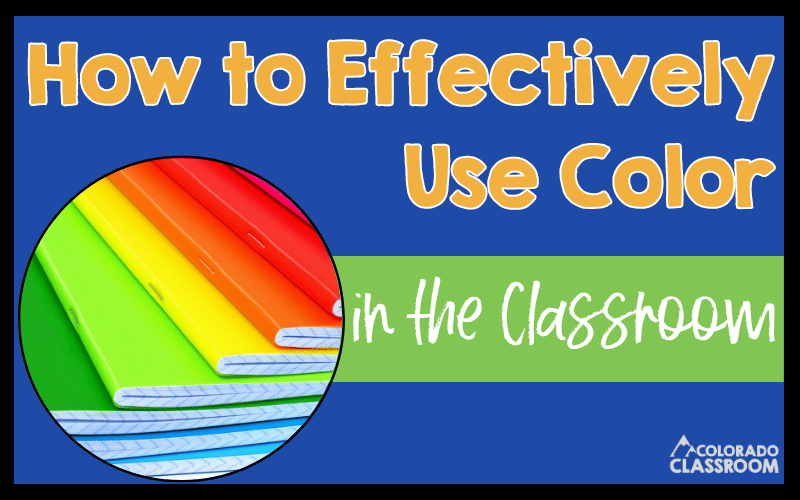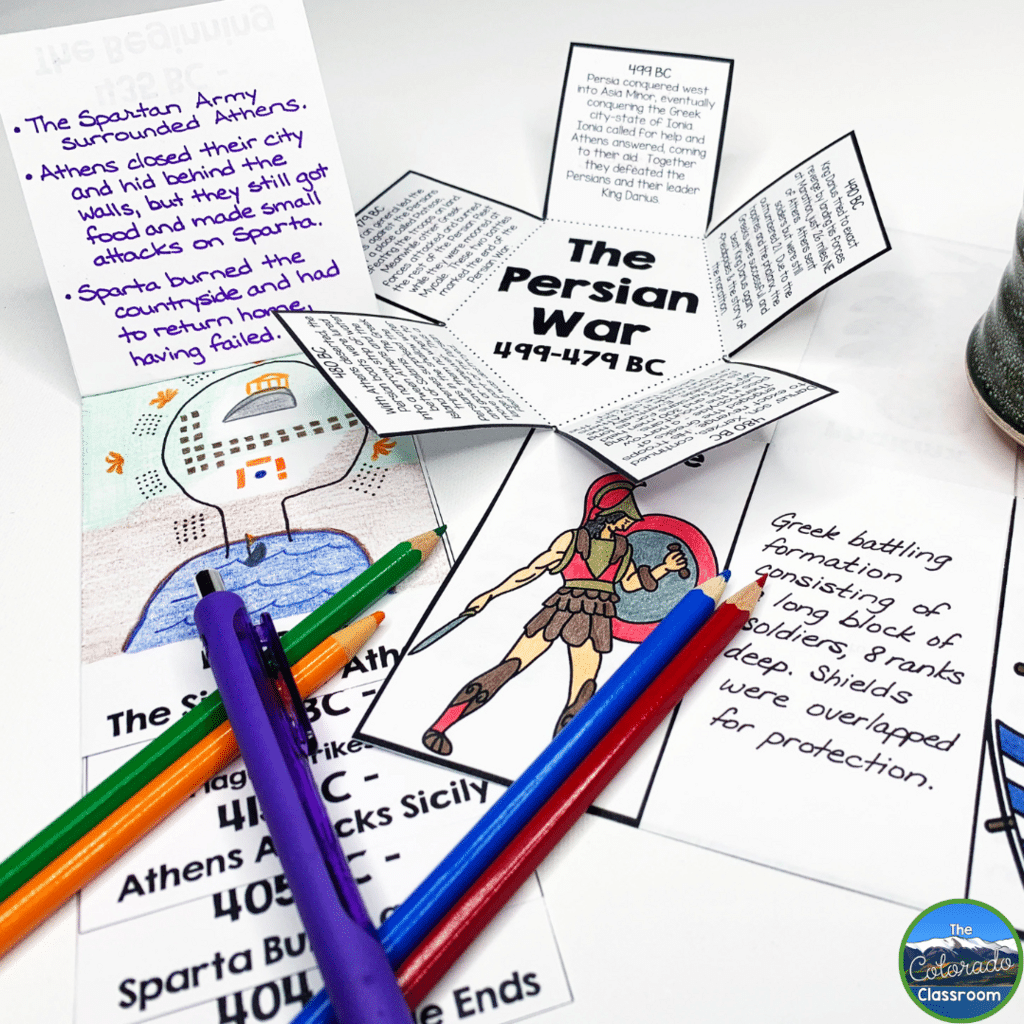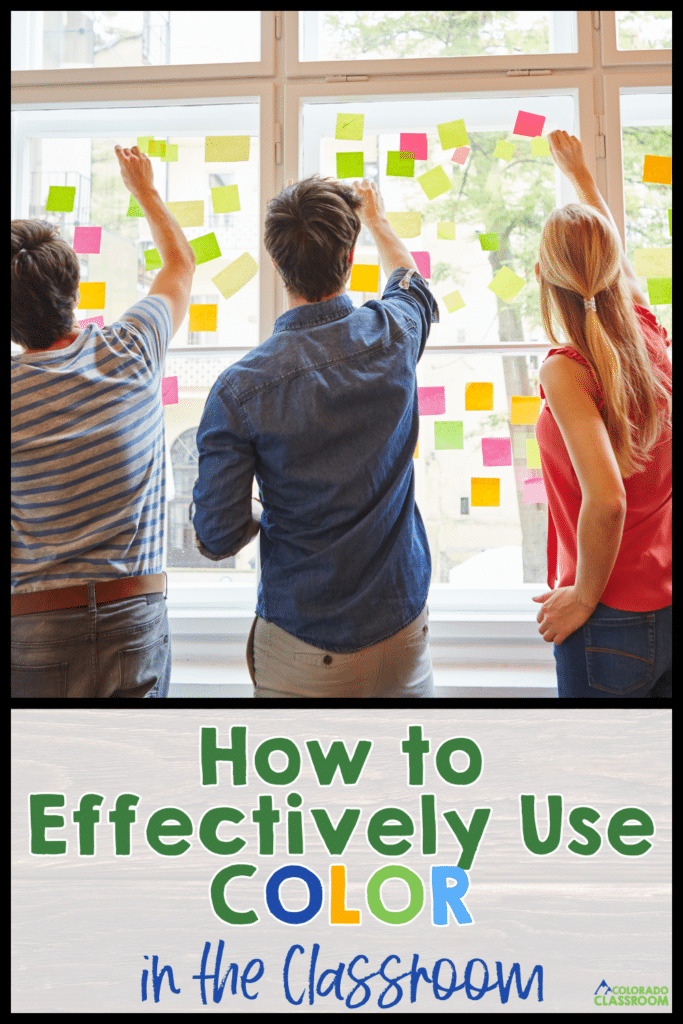How to Effectively Use Color in the Classroom
If you asked my first year teaching self about the impact of color on my students’ learning, I probably would have given you a generic answer. As I grew as a teacher, I was continuously learning about the different roles color plays in our classrooms for our students. Let me tell you, color in the classroom is such a game-changer! Whether it’s grabbing our students’ attention, helping them stay organized, or setting the right mood, color is more than just a pretty way to decorate. It actually affects how we process and retain information. Today, I’m walking you through some of the best ways to use color in the classroom and explaining why it works so well.

The Science Behind Using Color in the Classroom
Let’s start with why color in the classroom works so well for learning. Our brains process color before they process content. So when our students see a color, their brain is already ready to engage with whatever comes next. This makes color an incredible tool to help our students stay focused and remember what they’ve learned. Studies have shown that color improves attention span and increases the likelihood of recalling information by making it stand out from the typical black-and-white content they usually see.

I had the lucky opportunity to have Brigid Danziger from Math Giraffe on The Teaching Toolbox podcast explain more about color and its use in the classroom. In the episode, she explains how using color alongside written content can boost retention and recall. It’s all about dual coding, which is combining visuals (like color!) with language to help our students understand and remember concepts better.
When we use color in notes, worksheets, or even on the board, we’re helping students engage both the visual and linguistic parts of their brains. This combination strengthens connections, making it easier for them to retrieve the information when they need it later. Color also has the added benefit of breaking up dense information. By doing so, color makes it feel more manageable and less overwhelming for our students. So, when they encounter concepts presented with different colors, it allows their brains to focus more on processing and less on deciphering. Using color in the classroom helps our students hold onto that information for longer and more meaningfully.
How to Use Color in the Classroom to Organize
Color in the classroom isn’t just about learning. It’s also a lifesaver for staying organized! One of my favorite tricks is to assign a different color to each week. So, everything from behavior charts to grading sheets, homework, and notes follows that week’s color. It’s such an easy way to keep things sorted! Not only does it streamline my own workflow, but my students also love the consistency. They know exactly what to look for each week, making transitions smoother and reducing the chances of misplacing things.

I have also assigned colors to different subjects or blocks. For example, math might be red, science green, and so on. When my students walk into class and see the red folders or bins, they immediately know it’s time for math. It’s such a simple system, but it works wonders for reducing classroom chaos. Matching classroom materials like turn-in bins, folders, and notebooks to each class color keeps everything visually aligned. It makes it easier for everyone to stay organized.
I even encourage my students to take it a step further by color-coding their folders and notebooks and writing their assignments in their planners with matching colors. Imagine their math assignments written in red and their science tasks in green. It creates a routine that helps them stay on top of things without even thinking about it!
This system also reinforces content retention. When our students start associating colors with specific subjects, it adds another layer to their learning. They’re processing and recalling information from the content itself and the visual cues they’ve been seeing all week. It’s a little trick that goes a long way toward making the classroom feel more structured. It also helps our students develop good organizational habits they can carry into other areas of their lives!
Using Color in the Classroom to Enhance Learning
Now, let’s explore how color in the classroom can boost learning. Using color helps information move from working memory into long-term memory. When our students use colors in their notes or activities, they’re more likely to remember what they’ve learned later on. This visual cue makes it easier for them to recall facts, formulas, or key concepts because the color acts as a mental trigger to help them recall the information.

When our students highlight important sections in their notes with different colors, they’re not just making the page look more appealing. They’re reinforcing those concepts in their brains. The color stands out and grabs their attention. It creates a visual marker that their brain can go back to when they need to recall the information later.
Using color in classroom activities, such as sorting tasks by colored categories or using colored sticky notes for brainstorming, taps into that same brain-boosting power. The more we integrate color into learning, the more we’re helping our students actively engage with the material. This strengthens their retention. Plus, it makes learning feel more interactive and dynamic, which is a win-win for keeping students motivated and focused!
Color also breaks up dense information, making it feel less overwhelming. When everything is in black and white, it can be easy for our students to get lost or feel discouraged. A pop of color can re-energize their focus. It’s a simple but effective way to transform their learning experience into something more engaging and memorable.
How Color in the Classroom Affects Emotions and Focus
Color can change how our students feel in the classroom, too. Imagine how your students would feel and act walking into an all white classroom, with no color at all. This type of atmosphere would quench any excitement they had for learning or school. The sterile feel would likely diminish their participation and increase stress. While this type of classroom environment is not likely, it shows just how colors in the classroom can affect our students.

The colors you choose for your classroom decorations or materials can influence mood and focus. By being intentional with color in the classroom, you can help create the right atmosphere for learning and engagement, and even boost students’ moods!
For example, blue is known to promote calm and focus. It’s perfect for quieter activities like reading or math. Green is another calming color that can help our students feel balanced and focused, especially if they’re overwhelmed.
On the other hand, red is an energizing color. This makes it great for engaging our students during creative projects or active learning. It can also raise stress levels. I like to use red sparingly, maybe for more fast-paced tasks. Yellow and orange are warm, happy colors that promote creativity and collaboration. Purple is perfect for areas where our students are brainstorming or working on artistic activities.
Knowing this information allows you to make strategic decisions when it comes to classroom decor or the colors you use in your lessons.
Why Brain-Based Learning Loves Color in the Classroom
Research from Brain-Balanced Learning supports the idea that color in the classroom has a real impact on how our students engage with their work. Visuals and colors make our students more willing to participate because they’re naturally drawn to the stimulation that color provides. It’s fascinating how something as simple as adding a splash of color can make our students more excited about their tasks. Since our brains process color before they process content, it gives our students an extra boost when it comes to retaining information. Color acts like a mental anchor, helping our students better absorb and recall what they’re learning.

One of the things I love about color in the classroom is how it works hand-in-hand with visual learning techniques. When you pair color with note-taking strategies like doodling, sketch notes, or graphic organizers, the benefits really start to shine. Color can break up complex information. It can make it more digestible. Doodling or using graphic organizers helps our students visually map out concepts in a way that sticks. It’s all about using simple, brain-based tools to make learning easier and more fun!
Using color as part of these techniques keeps our students engaged and motivated. It makes even the most challenging subjects feel a bit more approachable. I’ve seen students light up when they’re given the chance to use color in their learning. It adds that creative touch that makes them want to dive deeper into the material. Whether it’s using different highlighters to emphasize key points or color-coding their graphic organizers, students are far more likely to stay focused and retain the information when color is involved.
Making Color in the Classroom Work for You
Using color in the classroom is one of the easiest and most effective ways to boost learning, improve organization, and create a positive environment for our students. Whether you’re assigning colors to materials, encouraging color-coded notes, or decorating with colors that match the mood you want to set, using color with intention can greatly impact student success. It’s a small change that makes a big difference. Color transforms the classroom into a more engaging and interactive space. When our students feel more organized and connected to their learning environment, they’re more motivated to participate and thrive.
If you’d like to learn more about using color in the classroom, make sure to listen to the full Teaching Toolbox podcast on the topic of color in the classroom.
Save for Later
Remember to save this post to your favorite teacher Pinterest board for quick access to this information about color in the classroom!


